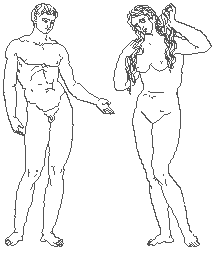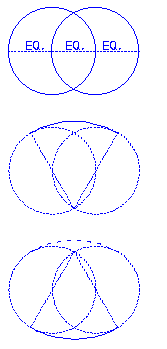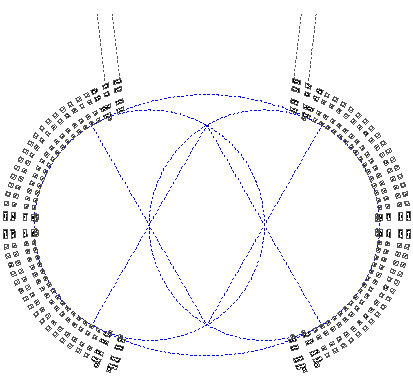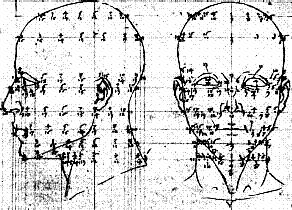Stephen Lauf
The Timepiece of Humanity
The Calendar Incarnate
Annunciation
Duality 1
Duality 2
The Metaphor
The Timepiece of Humanity
The Gauge
Chronosomatically Contemplating the Naval
| |

The reality of male and female is the most prominent duality manifested by the human body. The body abounds with many other dualities, however. Both externally and internally, the body displays a variety of paired features and organs. There is also, within the body, an ongoing shift from duality to singularity, and perhaps the greatest example of a move towards singularity is the sexual bond between male and female which creates a new individual.
| |
Duality II
Creation myths consistently demonstrate a link between duality and origins; primal acts of separation and polarization often manifest dual natures and dual conditions. Although myths are utterly without factual basis, this dualistic view of origins and creation may bear some truth, especially when considering the binary fission of cells, the wave-particle duality at the very core of quantum mechanics, and the enormous quantities of energy released through nuclear fission. The processes of separation, spitting, and cleavage, and polarization and opposition, appear to play vital roles in the creation of reality, and particularly the creation of dualities within reality.
The 17th and 18th century philosophy of dualism paid specific attention to the fundamental split within human nature: the body and the mind. The progressive stages of dualism's philosophical development began with body and mind being two equal and independent systems governed by a third and higher ordering system, and eventually ended with the dominance of the mind over the body. Kant's notion of the mind shaping worldly experience effectively eliminates dualism's basic premise. The two halves of the physical mind, however, strongly suggest that duality still remains a meaningful feature of human nature.
For humanity, the most viseral of dualities are literally those possessed of the human body. Humanity's corporal being, including the brain, is replete with dualities. The premiere duality of the human body is, of course, the division of male and female. Independent of sexual distinction, however, the external features of the body exhibit nine major pairs: eyes, ears, nostrils, lips, arms, hands, breasts, legs, and feet. A tenth pair is actually a set of two pairs involving sexual distinction, plus a further distinction of external versus internal: the external male testicles, and the internal female ovaries. Again independent of sexual distinction, some other internal features of the body continue to exhibit pairings: the kidneys, the lungs, the arteries and veins of the circulatory system, and ultimately the two halves of the brain. While the dualities of the human body are, for the most part, fairly obvious, there is also a virtually invisible duality within the body. The physiological process of metabolism employs both creative and destructive operations; anabolism is constructive metabolism and catabolism is destructive metabolism.
|
| |
The body, furthermore, establishes the dualities of orientation; the notion of back and front, and right and left are purely somatic functions. The right hand being, on average, stronger than the left hand also bears a direct relationship to the metaphysical duality of good and evil. The Latin words for right and left are dexter and sinister respectively. English derivatives of these words, such as dexterity and sinister, immediately display contrasting meanings; dexter has evolved to mean something positive, while sinister has evolved to mean something negative. The French words for right and left, adroit and gauche respectively, likewise, connote a positive and negative meaning in their English usage.
The corporal dualities comply with the notion that separation and polarization are duality's primal characteristics. The body's external and internal pairings literally embody the idea and process of separation, splitting, and cleavage. Metabolism and the reality of right and left, on the other hand, feature the idea and process of polarization or opposition. The relationship of duality to the human body is both physical and visceral, and it is, therefore, possible to speculate whether or not the corporal dualities are the prototypical dualities that inspired the dualistic disposition of creation myths.
According to Aristophane's myth, as Plato reiterates in the Symposium1, the human body was not always in its present form. The first human body had double the features of the present human body: two heads, four arms, and four legs. The first body was also capable of becoming a sphere, thus rendering the body perfect and swift. Sex, too, was complete and whole within one body. As the legend goes, these "perfect" humans threatened the gods, and Zeus had to resolve the potential danger. Zeus decided to make the primal humans less powerful by slicing them in two. He then asked Apollo to make some necessary design adjustments to the new "imperfect" body, and humans, thereafter, are in a constant search for union with another half.
Aristophane's myth adds a few new dimensions to the nature of duality. The myth suggests that the present physical condition of the human body is imperfect; it is but half of a formerly perfect self or individual. Besides featuring separation and splitting, and the opposition of a perfect and imperfect state, the myth also introduces the concepts of necessary adaptation, and a longing for reunification. Are formal adjustments and longing for a return to singularity as integral to duality as separation and opposition?
|
| |
1. "...the original human nature was not like the present, but different. The sexes were not two as they are now, but originally three in number; there was man, woman, and the union of the two, having a name corresponding to this double nature, which had once a real existence but is now lost, and the word `Androgynous' is only preserved as a term of reproach. In the second place, the primeval man was round, his back and sides forming a circle; and he had four hands and four feet, one head with two faces, looking opposite ways, set on a round neck and precisely alike; also four ears, two privy members, and the remainder to correspond. He could walk upright as men do, backward or forward as he pleased, and he could roll over and over at a great pace, turning on his four hands and four feet, eight in all, like tumblers going over and over with their legs in the air; this was when he wanted to run fast. Now the sexes were three, and such as I have described them; because sun, moon, and earth are three; and the man was originally the child of the sun, the woman of the earth, and the man-woman of the moon, which is made up of sun and earth, and they were all round and moved round and round like thier parents. Terrible was their might and strength, and the thoughts of their heart were great, and they made an attack upon the gods; of them is told the tale of Otys and Ephialtes who, as Homer says, dared to scale heaven, and would have laid hands upon the gods. Doubt reigned in the celestial councils. Should they kill them and annihilate the race with thunder bolts, as they had done the giants, then there would be an end of the sacrifices and worship which men offered them; but, on the other hand, the gods could not suffer their insolence to be unrestrained. At last, after a good deal of reflection. Zeus discovered a way. He said: `Me thinks I have a plan which will humble their pride and improve their manners; men shall continue to exist, but I will cut them in two and then they will be diminished in strength and increased in numbers; this will have the advantage of making them more profitable to us. They shall walk upright on two legs, and if they continue insolent and will not be quite, I will split them again and they shall hop about on a single leg.' He spoke and cut men in two, like a sorb apple which is halved for picking or as you might divide an egg with a hair; and as he cut them one after another, he bade Apollo give the face and the half of the neck a turn in order that the man might contemplate the section of himself: he would thus learn a lesson of humility. Apollo was also bidden to heal their wounds and compose their forms. So he gave a turn to the face and pulled the skin from the sides all over that which in our language is called the belly, like the purses which draw in, and a knot (the same which is called navel); he also molded the breast and took out most of the wrinkles, much as a shoemaker might smooth leather upon a last; he left a few, however, in the region of the belly and navel, as a memorial of the primal state. After the division the two parts of man, each desiring his other half, came together, and throwing their arms about one another, entwined in mutual embraces, longing to grow into one, they were on the point of dying from hunger and self-neglect because they did not like to do anything apart; and when one of the halves died and the other survived, the survivor sought another mate, man or woman -- and clung to that. They were being destroyed, when Zeus in pity of them invented a new plan: he turmed the parts of generation around to the front, for this had not always been their position, and they sowed the seed nolonger hitherto like grasshoppers in the ground, but in one another; and after the transposition the male generated in the female in order that by the mutual embraces of man and woman they might breed, and the race might continue..."
Plato (Benjamin Jowett, trans.), Symposium (Indianaplois: Bobbs-Merrill Company, Inc., 1956), pp. 30-32.
|



